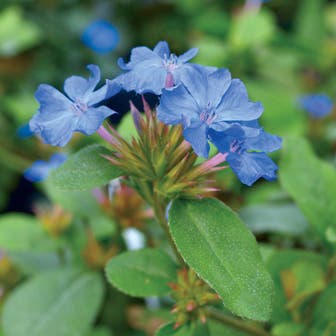My Cart
Checkout using your account
Checkout as a new customer
Creating an account has many benefits:
- See order and shipping status
- Track order history
- Check out faster
- Home
- Perennial Plants
- Ceratostigma / Plumbago
Low growing, spreading habit with clusters of blue blooms and fall color
Ceratostigma is a small genus of 8 species that includes herbaceous perennials, subshrubs, and small shrubs, some are evergreen, some deciduous. Ceratostigma plumbaginoides, commonly called plumbago, dwarf plumbago, or leadwort, is the species most often grown in home gardens. Recipient of the Royal Horticultural Society Award of Garden Merit, this award-winning perennial is a tough, rhizomatous plant with a low growing, trailing, spreading habit. It forms large colonies in optimum conditions, making it an excellent ground cover, perfect for erosion control on banks and slopes, but also nice for threading its way around perennial beds, covering bare ground. Beginning in late summer, plumbago flowers in prolific clusters of small indigo blue blooms for weeks, typically until first frost. Nectar and pollen rich, the 5-petaled flowers sustain bees, butterflies, and hummingbirds. Borne on wiry stems, the flowers rise above oval-shaped, medium-green leaves, which turn bronze-red to purple in autumn before falling for winter.
Two lesser-known species are also good choices for home gardens. Both set clusters of blue blooms in late summer and turn vibrant red in fall. Ceratostigma willmottanium (Chinese plumbago, Chinese leadwort) is also an RHS award winner. Growing between 2 to 4 feet tall and wide, this small deciduous shrub has a bushy habit of gracefully arching reddish-brown stems with lanceolate leaves. Ceratostigma griffithii (Burmese plumbago, Burmese leadwort) is a airy, semi-evergreen, woody subshrub that grows about 2 to 3 feet tall and 3 to 6 feet wide.
Easy to grow and low maintenance, plumbagos grow best in sunny to partly sunny locations with moist to dry, well-draining soil. They are drought tolerant and deer resistant.


